The Lunge: Most Avoided. Most Needed.
Let’s be honest—lunges don’t have the best reputation.
They get a lot of side-eye in exercise classes. They’re known for feeling awkward, messing with your balance, and making your legs burn. And if you’ve ever thought, “Nope, not for me,” you’re definitely not alone.
But here’s the thing most people don’t realize:
You’re already doing lunge-like movements every single day.
Getting out of the car? That’s a lunge.
Walking up the stairs? Yep—each step is a mini-lunge.
Picking something up from the floor and turning to put it away? That’s a lunge with a twist (literally).
The lunge is one of the most functional movements you can do. And when done with the right support and technique, it helps improve balance, single-leg strength, coordination, and confidence in your day-to-day life.
Why Lunges Matter
As we get older, one of the most important things we can train is the ability to support our weight on one leg while the other leg moves. That’s how walking works. That’s how turning quickly or changing direction works.
The lunge trains:
Hip and thigh strength for climbing stairs or getting up off the floor.
Core stability for staying upright and balanced when reaching or twisting.
Ankle and foot control—which helps prevent those stumbles that come out of nowhere.
It’s also one of the best ways to help prevent falls and regain your confidence on your feet.
“But What If I Can’t Do a Full Lunge?”
Good. You don’t need to. We never start with a full lunge.
We build up to it. Here’s how:
🟩 3 Exercises to Build Your Lunge Foundation
(Want to follow along? I demo all of these in a short video right here: The Lovely Lunge
1. Split Stance Hold (with Chair Support)
Stand with one foot in front of the other like you’re mid-step. Hold onto a chair or countertop.
✅ Hold for 10–20 seconds per side
✅ Feel the weight in both legs and keep your chest tall
This builds confidence in the position without movement yet.
2. Mini Knee Bends in Split Stance
From the same position, gently bend both knees just a few inches.
✅ Go slow and small—don’t aim for depth
✅ Push through the front heel to return to standing
This trains balance and quad strength without going too far.
3. Step-Backs
Stand tall, then step one foot straight back and return it next to the other.
✅ Hold onto something if needed
✅ Repeat 8–10 reps per leg
This teaches coordination and leg control—two essentials for lunges.
🟨 Ready for More? Try These Progressions
4. Supported Reverse Lunge
Hold on to a chair or wall. Step one leg back, bend both knees slightly, then return.
✅ Focus on keeping your balance
✅ Go as shallow or deep as feels good for you
5. Dynamic Split Squats (No Step)
Feet stay in place in split stance. Slowly bend and straighten both knees.
✅ 5–10 slow reps per side
✅ Great for building leg strength and control
You Don’t Have to Lunge Alone
We do this all the time in our small group sessions. You get support, guidance, and progressions that match your body—not a one-size-fits-all exercise from a YouTube video.
And here’s what we hear most often after someone practices lunges for a few weeks:
“I didn’t think I could do that. Now I feel stronger walking across the yard or going up the stairs.”
It’s not about perfect form. It’s about building trust in your body again.
Bottom line:
Don’t let lunges scare you off. With the right approach, they’re one of the best tools you can use to stay strong, steady, and independent.
📹 Watch the demo here: The Lovely Lunge
Or come join us in class—we’ll practice together!
👀 Up Next: The Push
If lunges are about stepping and stabilizing… push movements are about power, posture, and protecting your shoulders.
Think about pushing open a heavy door, getting up off the floor using your arms, and reaching overhead to put something away.
In the next blog, we’re diving into how simple push-based exercises (yes, even modified ones!) can strengthen your chest, shoulders, and arms—without putting stress on your joints.
You’ll learn:
✔ Why pushing matters more than just “arm strength”
✔ How to modify push-ups (no, you don’t have to go to the floor!)
✔ The secret to protecting your shoulders as you age
Stay tuned—your upper body will thank you.

